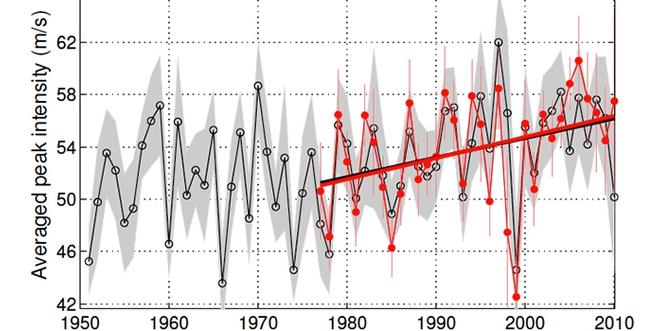Typhoons could intensify by 2100 under moderate climate change
by scripps.ucsd.edu on 1 Jul 2015

Peak intensity trend in typhoons Science Advances
Typhoon Haiyan, which devastated large portions of the Philippines in November 2013, was one of the strongest ocean storms ever recorded, killing at least 6,300 people. It set records for the strongest storm ever at landfall and for the highest sustained wind speed ever over one minute, hitting 315 kilometers per hour (194 miles per hour) when it reached the province of Eastern Samar.
Now a new analysis of what controls the peak intensity of typhoons suggests that under climate change this century, storms like Haiyan could get even stronger and more common. The NASA, National Science Foundation, and NOAA-funded study, led by researchers at Scripps Institution of Oceanography, UC San Diego, predicts the intensity of typhoons in the western Pacific Ocean to increase as much as 14 percent – nearly equivalent to an increase of one storm category – by century’s end even under a moderate future scenario of greenhouse gas emissions.
The study did not address the potential effects of more extreme climate scenarios on typhoon intensity, although Scripps climate researcher Wei Mei, the lead author of the study, said those scenarios would be expected to lead to even more amplified typhoon strength. The moderate scenario considered in the study assumes that carbon dioxide levels would reach 550 parts per million (ppm) by 2100. Currently, the
concentration of this greenhouse gas averages 404 ppm, a level already well elevated from the range of CO2 concentrations between 180 and 280 ppm prior to the Industrial Revolution.
Mei said that one remarkable aspect of the present-day trend is the unusual upper ocean warming rates over the low-latitude northwestern Pacific. The sea surface temperature in this region has increased by roughly 0.6° C (1.1° F) and the ocean temperature at depths of 75 meters (246 feet) has increased by about 0.75° C (1.4° F) since the mid-1970s.
These observed accelerated warming rates have already led to more intense storms in the region since the warmer water provides more fuel for storm intensity. The study projects that by the year 2100, the temperature of the upper ocean will be more than 1.6 degrees Celsius higher than the baseline average derived from the 50-year period from 1955-2005.
The study, “Northwestern Pacific typhoon intensity controlled by changes in ocean temperatures,” appeared in the journal Science Advances on May 29.
“Accurate projections of changes in tropical cyclone intensity can benefit society and inform policy making. Previous projections are based on theory and numerical modeling. We are tackling this issue from a different angle,” said Wei Mei of Scripps, the lead author of the study. “We first study the physical mechanisms for the observed variations in cyclone intensity, and then build a statistical model to project the future changes.”
'NOAA is pleased to be a co-sponsor of this study, which sheds further light on the oceanic conditions that control cyclone intensification,' said Craig McLean, NOAA's Assistant Administrator for Oceanic and Atmospheric Research. 'These results will help us better understand and prepare for the impacts of anticipated changes in storm strength and behavior.'
In an effort to understand the variability of the intensity tropical cyclones including typhoons, the authors employed a new approach by decomposing intensity into two components: intensification rate (akin to acceleration) and intensification duration. This methodology allows them to gain more insight into which climate conditions were most strongly associated with the peak amount of intensity from one year to another by influencing one or both of the two factors. They found that compared to atmospheric factors such as wind shear, atmospheric pressure, and vorticity, ocean temperature most strongly correlated to the rate of cyclone intensification.
Specifically, how strongly and quickly a cyclone can grow depends on two oceanic factors: pre-storm sea surface temperature and difference in temperature between the surface and subsurface. A warmer sea surface generally provides more energy for storm development. A large change in temperature from the surface to subsurface, however, can disrupt this flow of energy, because strong winds drive turbulence in the upper ocean, bringing cold water up from below and thereby cooling the sea surface.
The authors showed that in the current climate, changes in sea surface temperature and in vertical temperature difference contribute nearly equally. But under climate change, sea surface temperature change dominates, because the subsurface ocean warms at a similar rate as the surface, resulting in a modest change in the vertical temperature gradient.
“Our findings provide the first observational evidence for the dominance of upper ocean thermal structure in the interannual-to-decadal variability of typhoon lifetime peak intensity,” said co-author Shang-Ping Xie, the Roger Revelle Chair in Environmental Science at Scripps. “The observation-based empirical relationships allowed us to make the first statistical projection of typhoon intensity in a warming climate based on projected changes in upper ocean temperatures.”
Besides Mei and Xie, study co-authors include Francois Primeau of UC Irvine, James C. McWilliams of UCLA, and Claudia Pasquero of the University of Milano-Bicocca in Milan, Italy.
If you want to link to this article then please use this URL: www.sail-world.com/136070